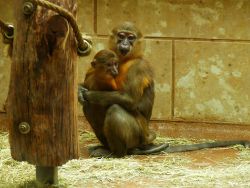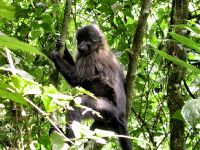Mangabey
| Mangabeys | ||||||||||
|---|---|---|---|---|---|---|---|---|---|---|
 Golden-bellied mangabey
| ||||||||||
| Scientific classification | ||||||||||
| ||||||||||
|
Lophocebus (crested mangabeys) |
Mangabey is the common name for the various Old World monkeys comprising the genera Lophocebus ( crested mangabeys) and Cercocebus (white-eyelid mangabeys), as well as the sole extant species in the genus Rungwecebus (Rungwecebus kipunji, the highland mangabey; also known as the Kipunji). They belong to the same family (Cercopithecinae) and tribe (Papionini) as macaques, baboons, and mandrills.
Classification
Mangabeys are Old World monkeys (family Cercopithecidae), which, along with apes of the Old World, comprise one of the three major informal groups of the biological order Primates, the other two groups being prosimians and New World monkeys. Old World monkeys typically are characterized by close-set nostrils that are downward or forward facing, a tubular ear bone, and a tail, if present, that is never prehensile (adapted for grasping or holding).
Mangabeys comprise three genera within the Old World monkeys:
- FAMILY CERCOPITHECIDAE
- Subfamily Cercopithecinae
- Tribe Cercopithecini
- Tribe Papionini
- Genus Lophocebus - crested mangabeys
- Genus Rungwecebus - Highland Mangabey
- Genus Cercocebus - white-eyelid mangabeys
- Genus Macaca - macaques
- Genus Papio - baboons
- Genus Theropithecus - Gelada
- Genus Mandrillus - Drill and Mandrill
- Subfamily Colobinae
- Subfamily Cercopithecinae
Crested mangabeys
| Crested mangabeys[1][2] | ||||
|---|---|---|---|---|
 juvenile Grey-cheeked mangabey
| ||||
| Scientific classification | ||||
| ||||
|
Lophocebus albigena |
The crested mangabeys are West-African Old World monkeys, belonging to the genus Lophocebus. They tend to have dark skin, eyelids that match their facial skin, and crests of hair on their heads. Another genus of mangabeys, Cercocebus, was once thought to be very closely related, so much so that all the species were in one genus. However, it is now understood that Lophocebus species are more closely related to the baboons in genus Papio, while the Cercocebus species are more closely related to the Mandrill. In 2006, the Highland Mangabey was moved from Lophocebus to a new genus, Rungwecebus, the first new primate genus in 83 years.
Species
- Genus Lophocebus[1][2][3]
- Grey-cheeked Mangabey, Lophocebus albigena
- Black Crested Mangabey, Lophocebus aterrimus
- Opdenbosch's Mangabey, Lophocebus opdenboschi
- Uganda Mangabey, Lophocebus ugandae
- Johnston's Mangabey, Lophocebus johnstoni
- Osman Hill's Mangabey, Lophocebus osmani
Highland mangabey
[[image:Kipunji walking h.jpg|left|200px|Highland mangabey (Rungwecebus kipunji)
The Kipunji (Rungwecebus kipunji) is a species of Old World monkey that lives in the highland forests of Tanzania. Also known as the Highland Mangabey, it is about three feet long and has long brown fur, which stands in tufts on the sides and top of its head. Its face and eyelids are uniformly black. The Kipunji is arboreal in its habits. All the males of this mangabey species emit a loud call to coordinate spacing between different groups. The Kipunji has a unique call, described as a 'honk-bark', which distinguishes it from its close relatives the Grey-cheeked Mangabey and the Black Crested Mangabey, whose calls are described as 'whoop-gobbles'.
Perhaps fewer than 1,000 of the animals live in the highland Ndundulu Forest Reserve, an unprotected forest adjacent to Udzungwa Mountains National Park, and in a disjunct population 250 miles away on Mount Rungwe and in Kitulo National Park, which is adjacent to it. The forest at Rungwe is highly degraded, and fragmentation of the remaining forest threatens to split that population into three smaller populations. The Ndundulu forest is in better shape, but the population there is smaller. The monkey will likely be classified as a critically endangered species.
The Kipunji was independently discovered by researchers from the Wildlife Conservation Society (WCS), the University of Georgia (UGA) and Conservation International (CI), in December 2003 and July 2004, making it the first new African monkey species discovered since the Sun-tailed Monkey in 1984.[4] Originally assigned to the genus Lophocebus,[4] genetic and morphological tests showed that it is more closely related to the baboons (genus Papio) than to the other mangabeys in the genus Lophocebus and that the genus is diphyletic, meaning that species with differing genealogies have been mistakenly lumped together. Scientists have assigned it to a new genus, Rungwecebus, named after Mount Rungwe, where it is found.[5]
Rungwecebus is the first new monkey genus to be discovered since Allen's Swamp Monkey in 1923, according to researchers.[6]
White-eyelid mangabeys
| White-eyelid mangabeys | ||||||||||||
|---|---|---|---|---|---|---|---|---|---|---|---|---|
| [[image:Barcelona.Zoologico.Mangabey.Gris.jpg|230px|Collared Mangabey (Cercocebus torquatus)]] Collared Mangabey (Cercocebus torquatus)
| ||||||||||||
| Scientific classification | ||||||||||||
| ||||||||||||
| Cercocebus fuliginosus É. Geoffroy, 1812 (= Simia (Cercopithecus) aethiops torquatus, Kerr, 1792) | ||||||||||||
|
Cercocebus atys |
The white-eyelid mangabeys are West-African Old World monkeys, belonging to the genus Cercocebus. They are characterized by their bare upper eye-lids which are lighter than their facial skin colouring, and the uniformly coloured hairs of the fur. The other two genera of mangabeys, Lophocebus and Rungwecebus, were once thought to be very closely related to Cercocebus, so much so that all the species were in one genera. However, it is now understood that Lophocebus and Rungwecebus species are more closely related to the baboons in genus Papio, while the Cercocebus species are more closely related to the Mandrill.
Species
- Genus Cercocebus
- Sooty Mangabey, Cercocebus atys
- Collared Mangabey, Cercocebus torquatus
- Agile Mangabey, Cercocebus agilis
- Golden-bellied Mangabey, Cercocebus chrysogaster
- Tana River Mangabey, Cercocebus galeritus
- Sanje Mangabey, Cercocebus sanjei
ReferencesISBN links support NWE through referral fees
- ↑ 1.0 1.1 C. Groves, "Order Primates," "Order Monotremata," (and select other orders). Page(s) 160-161 in D. E. Wilson and D. M. Reeder, eds., Mammal Species of the World, 3rd edition, Johns Hopkins University Press (2005). ISBN 0801882214.
- ↑ 2.0 2.1 New monkey species in Mabira - expert (2007-02-16). Retrieved 2007-02-17.
- ↑ Groves, Colin (2007). The Endemic Uganda Mangabey, Lophocebus ugandae, and Other Members of the albigena-Group (Lophocebus). Primate Conservation 22.
- ↑ 4.0 4.1 Jones, Trevor and Carolyn L. Ehardt, Thomas M. Butynski, Tim R. B. Davenport, Noah E. Mpunga, Sophy J. Machaga, Daniela W. De Luca (2005). The Highland Mangabey Lopocebus kipunji: A New Species of African Monkey. Science 308 (5725): 1161–1164.
- ↑ Davenport, Tim R. B. and William T. Stanley, Eric J. Sargis, Daniela W. De Luca, Noah E. Mpunga, Sophy J. Machaga, and Link E. Olson (2006). A New Genus of African Monkey, Rungwecebus: Morphology, Ecology, and Molecular Phylogenetics. Science 312: 1378.
- ↑ "Scientists Discover New Monkey Genus In Africa"
- C. Groves, "Order Primates," "Order Monotremata," (and select other orders). Page(s) 153-154 in D. E. Wilson and D. M. Reeder, eds., Mammal Species of the World, 3rd edition, Johns Hopkins University Press (2005). ISBN 0801882214.
External links
- Primate Info Net Lophocebus Factsheets
- Primate Info Net Cercocebus Factsheets
- ARKive - images and movies of the highland mangabey (Lophocebus kipunji)
- BBC: New African monkey discovered
- BBC: New genus of African monkey found
- African monkey reshapes the tree of life
- New scientist: New monkey species discovered in Africa
- Press release from the Wildlife Conservation Society
- http://news.bbc.co.uk/1/hi/sci/tech/4759535.stm
- http://news.bbc.co.uk/player/nol/newsid_4760000/newsid_4762300/4762373.stm?bw=bb&mp=rm&news=1&bbcws=1
- http://www.wcs.org/international/Africa/Tanzania/highlandmangabey WCS profile of Highland Mangabey]
- National Science Foundation press release
- Highland Mangabey's honk-bark (in .WAV format)
- Video of Highland Mangabey (in MPEG format)
- ITIS Report: Lophocebus kipunji (Accessed September 28, 2005)
Credits
New World Encyclopedia writers and editors rewrote and completed the Wikipedia article in accordance with New World Encyclopedia standards. This article abides by terms of the Creative Commons CC-by-sa 3.0 License (CC-by-sa), which may be used and disseminated with proper attribution. Credit is due under the terms of this license that can reference both the New World Encyclopedia contributors and the selfless volunteer contributors of the Wikimedia Foundation. To cite this article click here for a list of acceptable citing formats.The history of earlier contributions by wikipedians is accessible to researchers here:
The history of this article since it was imported to New World Encyclopedia:
Note: Some restrictions may apply to use of individual images which are separately licensed.